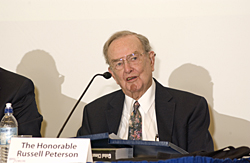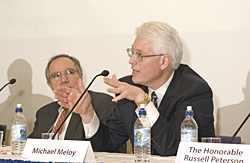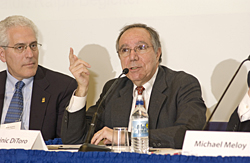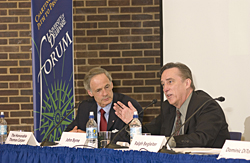6:30 p.m., May 11, 2008--Climate change and measures that might be taken to stem the adverse effects of global warming were highlighted by environmental experts and policymakers who shared their ideas on sustainability in a panel discussion moderated by Ralph J. Begleiter, Rosenberg Professor of Communication and Distinguished Journalist in Residence at UD.
The panel, titled “Climate Change: New Thinking for New Weather,” included U.S. Sen. Tom Carper; John Byrne, a member of the Nobel Prize-winning U.N. Intergovernmental Panel on Climate Change and director of UD's Center for Energy and Environmental Policy; Dominic M. DiToro, Edward C. Davis Professor of Civil and Environmental Engineering at UD; Russell W. Peterson, former governor of Delaware and former president of the National Audubon Society; and Michael Meloy, EG '80, a lawyer with 25 years of experience in the environmental field.
“By now, I'm sure everyone in this room has heard of climate change,” Begleiter said, painting his opening remarks with descriptions of melting polar ice caps, giant tsunamis and unbridled hurricanes. “Very likely, you've heard about the debate, which has been going on for over a decade now over whether global warming is a natural phenomenon or one caused by our own actions on Earth.”

Begleiter touched on UD's own interest in and research on global warming before introducing Byrne, who opened his remarks by putting a human face on global warming and stressing that “the problem of climate change is really deeply ours.
“There is no other civilization,” he said, “that could have changed the chemistry of the atmosphere, altered the ways in which a drought series occurs or affected the intensity of storms.”
Byrne said that humans have overwhelmed the Earth's ability to recycle carbon. “The wealthy world is clearly the focus of the problem, and our challenge as humanity as a whole is to cut the emissions down by 60 percent..., and we have until roughly mid-century to accomplish that.”
Byrne emphasized efforts on many fronts are required, including relying more on renewable energy sources, such as wind and solar power, and policing our own usage habits. “We have to do everything we can with renewable energy,” he said, “but we have to do a lot more, as well--not just one thing.”DiToro brought an engineer's perspective to the problem of climate change. “Engineers are applied scientists,” DiToro said, “and if you think about climate change and what is happening to some of the systems that we study, it's pretty clear that the engineers are going to have to do something.
“The change in climate is gong to affect the water cycle in a serious way,” DiToro continued. “We've already begun to see the severity of storms.”

DiToro spoke about the vulnerability of both Delaware and Maryland to rising sea levels caused by global warming and said that they “are the most at-risk states on the East Coast” for storm damage. While engineers might be the ones to know how to fix things, they can't do it without the help of public policymakers, DiToro said.
Peterson said that during his years as governor of Delaware he worked to implement environmental policies and ran into resistance.
“I had the opportunity to work in the early 1970s on convincing a reluctant executive branch to prepare environmental impact statements as required by the national Environmental Policy Act,” Peterson said. “The forces that worked against such analysis were powerful and many. That will be especially true for a project dealing with such a threatening, far-reaching and all-encompassing problem as global warming.”
Peterson outlined some of the steps that citizens, on their own, can take to help stem the tide of environmental and global woes, such as limiting the number of children to two per family and embracing renewable sources of energy. He also talked about the proposed wind power-harnessing project in Coastal Delaware.“The people of Delaware are overwhelmingly behind the wind plant, but unfortunately entities with serious conflict of interest are fighting it, and the time for action is now,” Peterson said.
Meloy focused on policymaking. “In contrast to the federal inaction, we have seen a great deal of action at the state and local levels,” he said. “States and municipalities have jumped into the void that's been created. This issue is devolving down to the smallest unit of government, and while it may from some perspectives be a good idea to allow states and local municipalities to be incubators of thought on environmental issues, it creates a patchwork quilt of regulation and regulatory approaches that is an enormous compliance challenge.”
Carper said he is working on “cap and trade” legislation, which would put a cap on the amount of allowable CO2 emissions and then over time ratchet down the amount and give credits to entities that are compliant. He said that a goal of the proposed legislation is to reduce CO2 emissions by 2050 to about 70 percent below what they were in 1990.
Those who reduce CO2 emissions would accumulate valuable credits, Carper said. “As the cap comes down, we're going to have an auction,” he said, “and by bringing down the amount of CO2 we'll create a lot of [revenue]. I'm not talking about millions of dollars, or even billions of dollars, I'm talking about trillions of dollars.”
These funds would be used to speed the development of more sustainable technology, he said, such as highly efficient trains and fuel-cell-powered buses. He added that the money would also go toward creating a hydrogen infrastructure to help support fuel-cell vehicles and toward the creation of new heating technologies.
The session concluded with panelists fielding questions from members of the audience.Article by Becca Hutchinson
Photos by Duane Perry




